Organizational change management PDF
VerifiedAdded on 2021/12/08
|16
|3845
|44
AI Summary
Contribute Materials
Your contribution can guide someone’s learning journey. Share your
documents today.
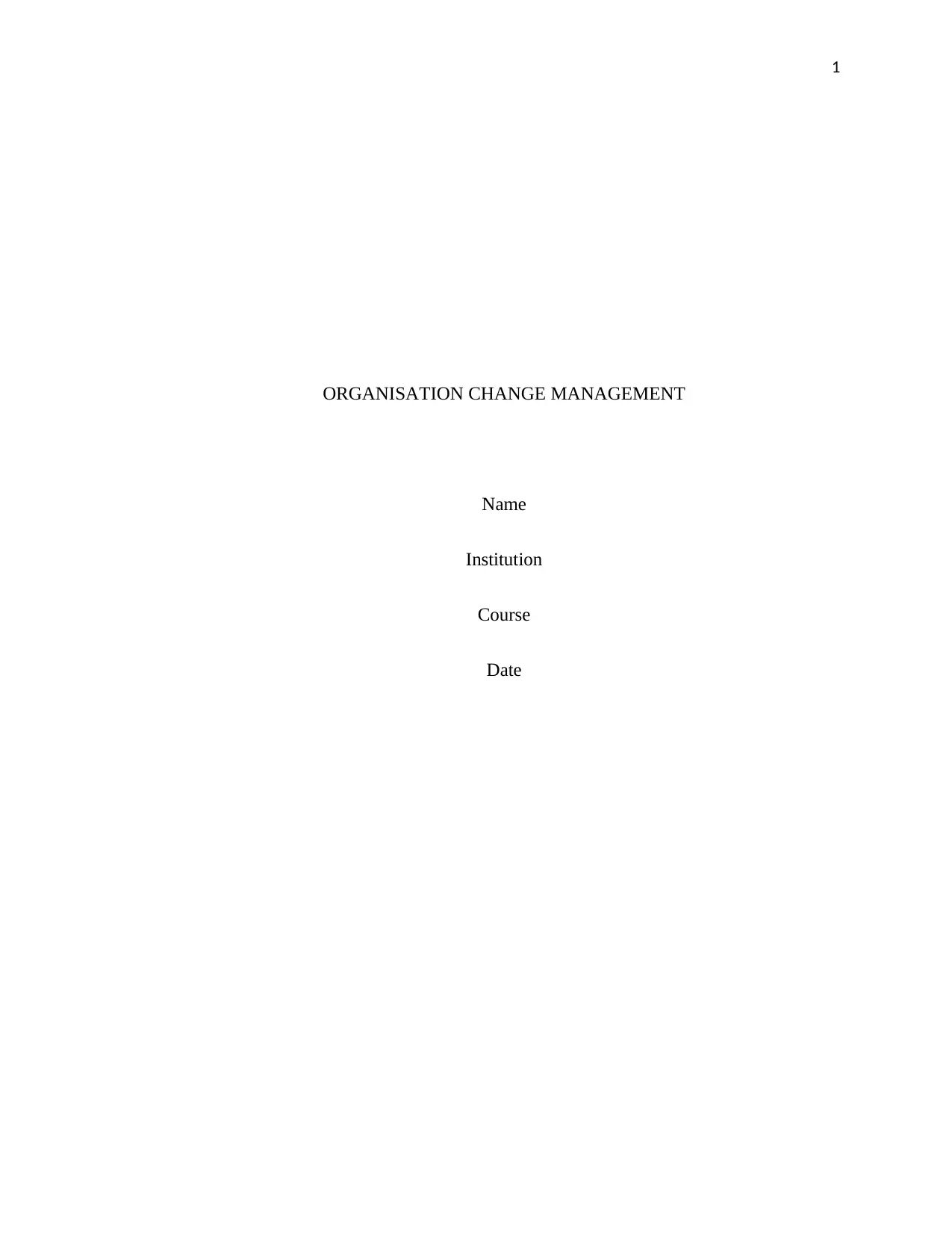
1
ORGANISATION CHANGE MANAGEMENT
Name
Institution
Course
Date
ORGANISATION CHANGE MANAGEMENT
Name
Institution
Course
Date
Secure Best Marks with AI Grader
Need help grading? Try our AI Grader for instant feedback on your assignments.
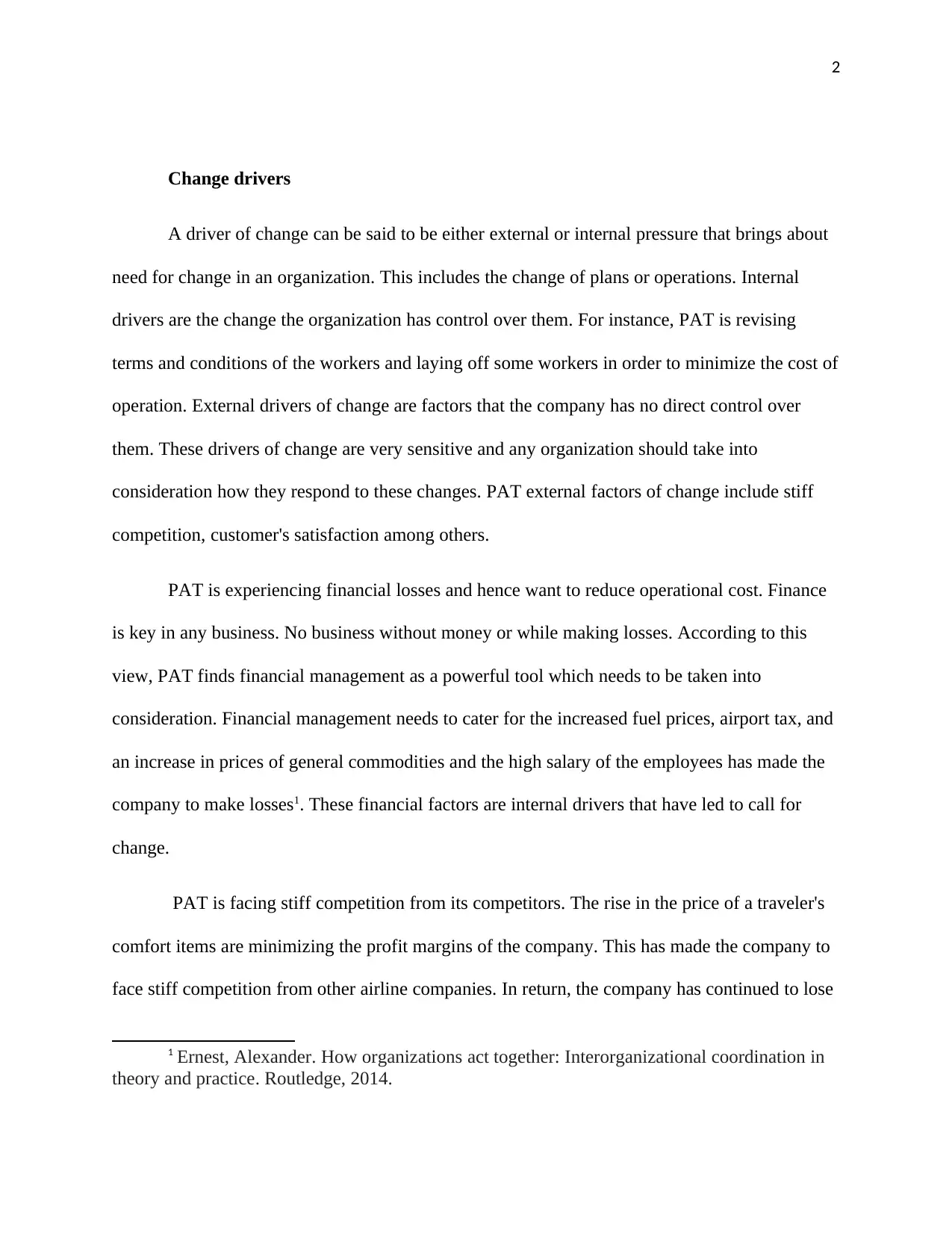
2
Change drivers
A driver of change can be said to be either external or internal pressure that brings about
need for change in an organization. This includes the change of plans or operations. Internal
drivers are the change the organization has control over them. For instance, PAT is revising
terms and conditions of the workers and laying off some workers in order to minimize the cost of
operation. External drivers of change are factors that the company has no direct control over
them. These drivers of change are very sensitive and any organization should take into
consideration how they respond to these changes. PAT external factors of change include stiff
competition, customer's satisfaction among others.
PAT is experiencing financial losses and hence want to reduce operational cost. Finance
is key in any business. No business without money or while making losses. According to this
view, PAT finds financial management as a powerful tool which needs to be taken into
consideration. Financial management needs to cater for the increased fuel prices, airport tax, and
an increase in prices of general commodities and the high salary of the employees has made the
company to make losses1. These financial factors are internal drivers that have led to call for
change.
PAT is facing stiff competition from its competitors. The rise in the price of a traveler's
comfort items are minimizing the profit margins of the company. This has made the company to
face stiff competition from other airline companies. In return, the company has continued to lose
1 Ernest, Alexander. How organizations act together: Interorganizational coordination in
theory and practice. Routledge, 2014.
Change drivers
A driver of change can be said to be either external or internal pressure that brings about
need for change in an organization. This includes the change of plans or operations. Internal
drivers are the change the organization has control over them. For instance, PAT is revising
terms and conditions of the workers and laying off some workers in order to minimize the cost of
operation. External drivers of change are factors that the company has no direct control over
them. These drivers of change are very sensitive and any organization should take into
consideration how they respond to these changes. PAT external factors of change include stiff
competition, customer's satisfaction among others.
PAT is experiencing financial losses and hence want to reduce operational cost. Finance
is key in any business. No business without money or while making losses. According to this
view, PAT finds financial management as a powerful tool which needs to be taken into
consideration. Financial management needs to cater for the increased fuel prices, airport tax, and
an increase in prices of general commodities and the high salary of the employees has made the
company to make losses1. These financial factors are internal drivers that have led to call for
change.
PAT is facing stiff competition from its competitors. The rise in the price of a traveler's
comfort items are minimizing the profit margins of the company. This has made the company to
face stiff competition from other airline companies. In return, the company has continued to lose
1 Ernest, Alexander. How organizations act together: Interorganizational coordination in
theory and practice. Routledge, 2014.
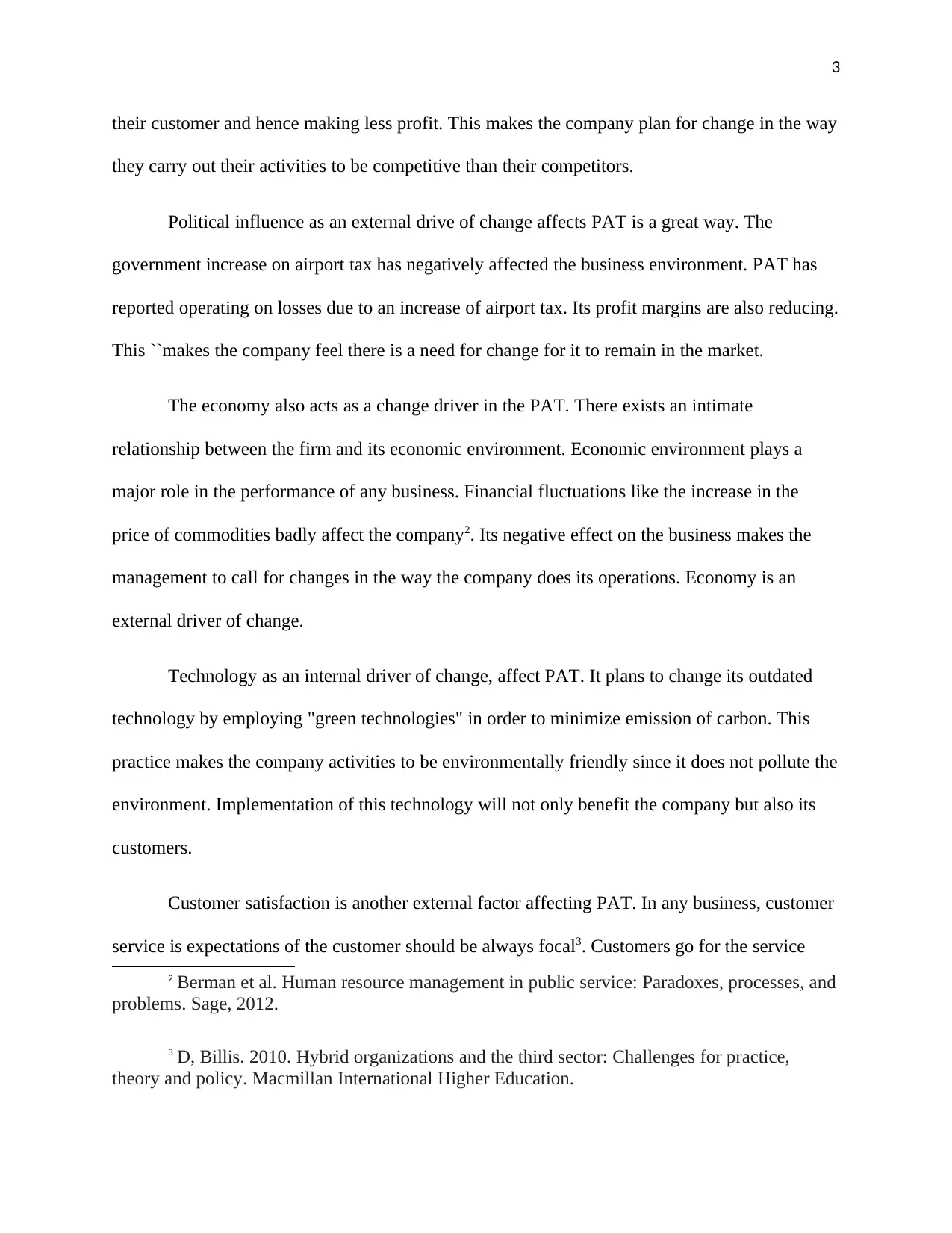
3
their customer and hence making less profit. This makes the company plan for change in the way
they carry out their activities to be competitive than their competitors.
Political influence as an external drive of change affects PAT is a great way. The
government increase on airport tax has negatively affected the business environment. PAT has
reported operating on losses due to an increase of airport tax. Its profit margins are also reducing.
This ``makes the company feel there is a need for change for it to remain in the market.
The economy also acts as a change driver in the PAT. There exists an intimate
relationship between the firm and its economic environment. Economic environment plays a
major role in the performance of any business. Financial fluctuations like the increase in the
price of commodities badly affect the company2. Its negative effect on the business makes the
management to call for changes in the way the company does its operations. Economy is an
external driver of change.
Technology as an internal driver of change, affect PAT. It plans to change its outdated
technology by employing "green technologies" in order to minimize emission of carbon. This
practice makes the company activities to be environmentally friendly since it does not pollute the
environment. Implementation of this technology will not only benefit the company but also its
customers.
Customer satisfaction is another external factor affecting PAT. In any business, customer
service is expectations of the customer should be always focal3. Customers go for the service
2 Berman et al. Human resource management in public service: Paradoxes, processes, and
problems. Sage, 2012.
3 D, Billis. 2010. Hybrid organizations and the third sector: Challenges for practice,
theory and policy. Macmillan International Higher Education.
their customer and hence making less profit. This makes the company plan for change in the way
they carry out their activities to be competitive than their competitors.
Political influence as an external drive of change affects PAT is a great way. The
government increase on airport tax has negatively affected the business environment. PAT has
reported operating on losses due to an increase of airport tax. Its profit margins are also reducing.
This ``makes the company feel there is a need for change for it to remain in the market.
The economy also acts as a change driver in the PAT. There exists an intimate
relationship between the firm and its economic environment. Economic environment plays a
major role in the performance of any business. Financial fluctuations like the increase in the
price of commodities badly affect the company2. Its negative effect on the business makes the
management to call for changes in the way the company does its operations. Economy is an
external driver of change.
Technology as an internal driver of change, affect PAT. It plans to change its outdated
technology by employing "green technologies" in order to minimize emission of carbon. This
practice makes the company activities to be environmentally friendly since it does not pollute the
environment. Implementation of this technology will not only benefit the company but also its
customers.
Customer satisfaction is another external factor affecting PAT. In any business, customer
service is expectations of the customer should be always focal3. Customers go for the service
2 Berman et al. Human resource management in public service: Paradoxes, processes, and
problems. Sage, 2012.
3 D, Billis. 2010. Hybrid organizations and the third sector: Challenges for practice,
theory and policy. Macmillan International Higher Education.
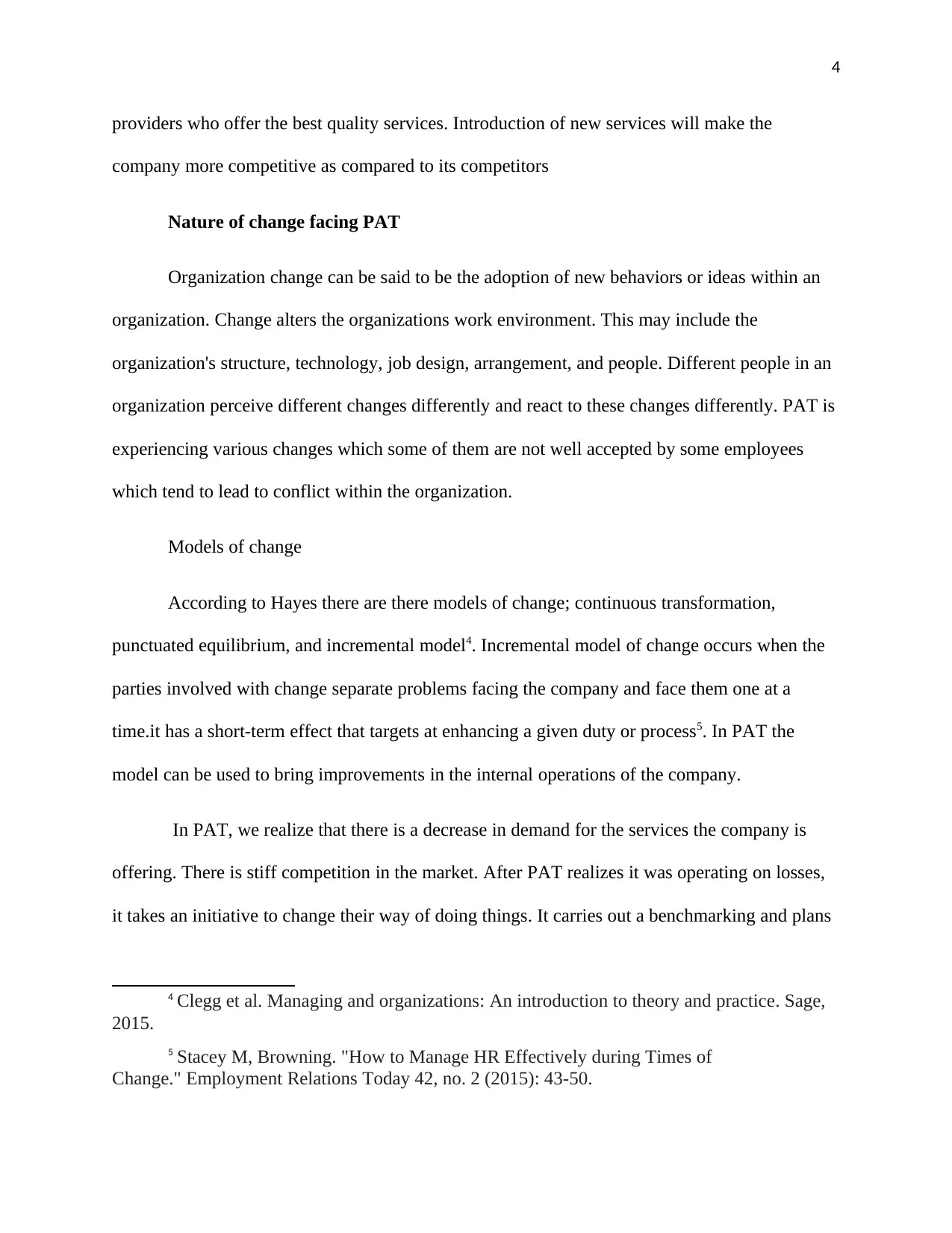
4
providers who offer the best quality services. Introduction of new services will make the
company more competitive as compared to its competitors
Nature of change facing PAT
Organization change can be said to be the adoption of new behaviors or ideas within an
organization. Change alters the organizations work environment. This may include the
organization's structure, technology, job design, arrangement, and people. Different people in an
organization perceive different changes differently and react to these changes differently. PAT is
experiencing various changes which some of them are not well accepted by some employees
which tend to lead to conflict within the organization.
Models of change
According to Hayes there are there models of change; continuous transformation,
punctuated equilibrium, and incremental model4. Incremental model of change occurs when the
parties involved with change separate problems facing the company and face them one at a
time.it has a short-term effect that targets at enhancing a given duty or process5. In PAT the
model can be used to bring improvements in the internal operations of the company.
In PAT, we realize that there is a decrease in demand for the services the company is
offering. There is stiff competition in the market. After PAT realizes it was operating on losses,
it takes an initiative to change their way of doing things. It carries out a benchmarking and plans
4 Clegg et al. Managing and organizations: An introduction to theory and practice. Sage,
2015.
5 Stacey M, Browning. "How to Manage HR Effectively during Times of
Change." Employment Relations Today 42, no. 2 (2015): 43-50.
providers who offer the best quality services. Introduction of new services will make the
company more competitive as compared to its competitors
Nature of change facing PAT
Organization change can be said to be the adoption of new behaviors or ideas within an
organization. Change alters the organizations work environment. This may include the
organization's structure, technology, job design, arrangement, and people. Different people in an
organization perceive different changes differently and react to these changes differently. PAT is
experiencing various changes which some of them are not well accepted by some employees
which tend to lead to conflict within the organization.
Models of change
According to Hayes there are there models of change; continuous transformation,
punctuated equilibrium, and incremental model4. Incremental model of change occurs when the
parties involved with change separate problems facing the company and face them one at a
time.it has a short-term effect that targets at enhancing a given duty or process5. In PAT the
model can be used to bring improvements in the internal operations of the company.
In PAT, we realize that there is a decrease in demand for the services the company is
offering. There is stiff competition in the market. After PAT realizes it was operating on losses,
it takes an initiative to change their way of doing things. It carries out a benchmarking and plans
4 Clegg et al. Managing and organizations: An introduction to theory and practice. Sage,
2015.
5 Stacey M, Browning. "How to Manage HR Effectively during Times of
Change." Employment Relations Today 42, no. 2 (2015): 43-50.
Secure Best Marks with AI Grader
Need help grading? Try our AI Grader for instant feedback on your assignments.
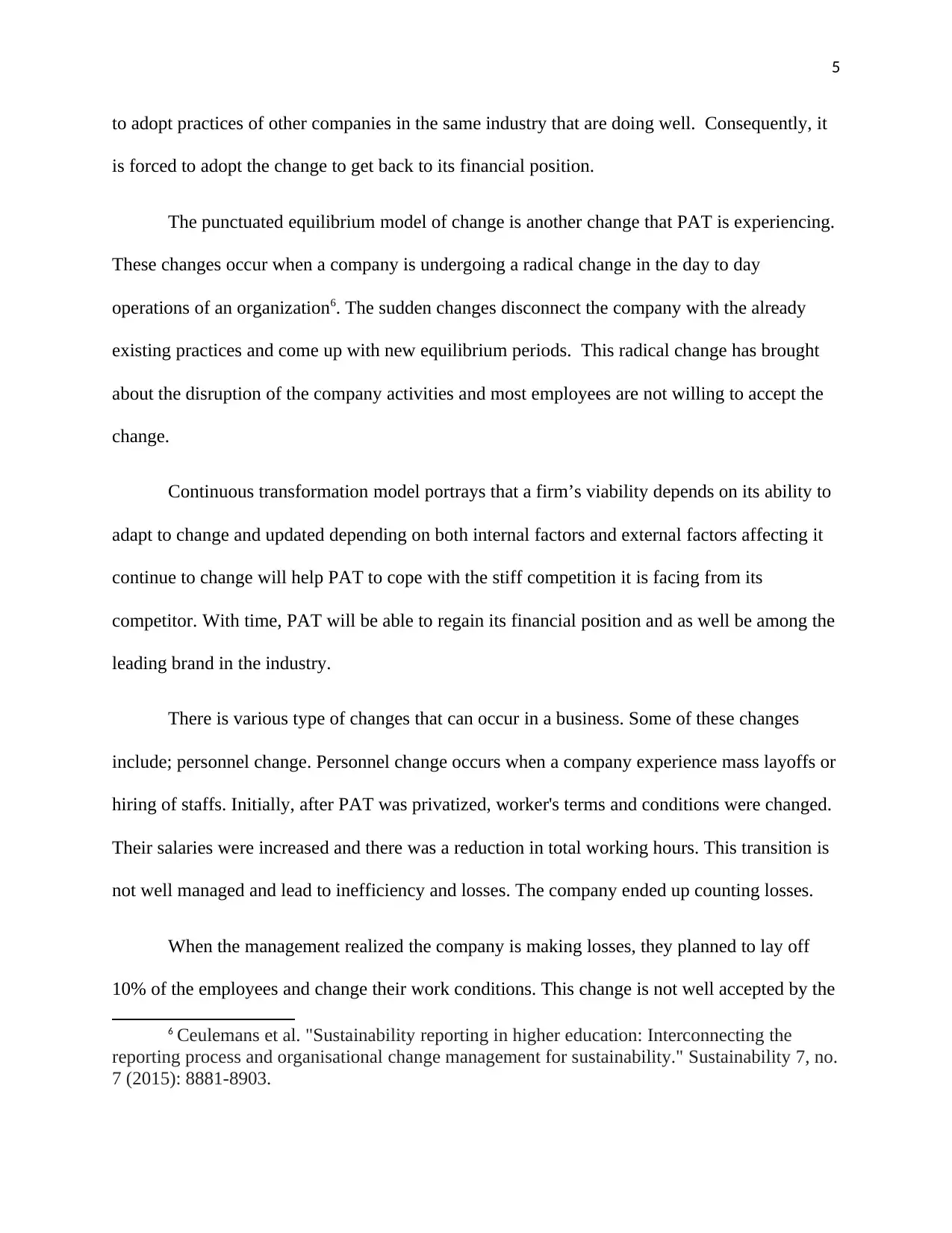
5
to adopt practices of other companies in the same industry that are doing well. Consequently, it
is forced to adopt the change to get back to its financial position.
The punctuated equilibrium model of change is another change that PAT is experiencing.
These changes occur when a company is undergoing a radical change in the day to day
operations of an organization6. The sudden changes disconnect the company with the already
existing practices and come up with new equilibrium periods. This radical change has brought
about the disruption of the company activities and most employees are not willing to accept the
change.
Continuous transformation model portrays that a firm’s viability depends on its ability to
adapt to change and updated depending on both internal factors and external factors affecting it
continue to change will help PAT to cope with the stiff competition it is facing from its
competitor. With time, PAT will be able to regain its financial position and as well be among the
leading brand in the industry.
There is various type of changes that can occur in a business. Some of these changes
include; personnel change. Personnel change occurs when a company experience mass layoffs or
hiring of staffs. Initially, after PAT was privatized, worker's terms and conditions were changed.
Their salaries were increased and there was a reduction in total working hours. This transition is
not well managed and lead to inefficiency and losses. The company ended up counting losses.
When the management realized the company is making losses, they planned to lay off
10% of the employees and change their work conditions. This change is not well accepted by the
6 Ceulemans et al. "Sustainability reporting in higher education: Interconnecting the
reporting process and organisational change management for sustainability." Sustainability 7, no.
7 (2015): 8881-8903.
to adopt practices of other companies in the same industry that are doing well. Consequently, it
is forced to adopt the change to get back to its financial position.
The punctuated equilibrium model of change is another change that PAT is experiencing.
These changes occur when a company is undergoing a radical change in the day to day
operations of an organization6. The sudden changes disconnect the company with the already
existing practices and come up with new equilibrium periods. This radical change has brought
about the disruption of the company activities and most employees are not willing to accept the
change.
Continuous transformation model portrays that a firm’s viability depends on its ability to
adapt to change and updated depending on both internal factors and external factors affecting it
continue to change will help PAT to cope with the stiff competition it is facing from its
competitor. With time, PAT will be able to regain its financial position and as well be among the
leading brand in the industry.
There is various type of changes that can occur in a business. Some of these changes
include; personnel change. Personnel change occurs when a company experience mass layoffs or
hiring of staffs. Initially, after PAT was privatized, worker's terms and conditions were changed.
Their salaries were increased and there was a reduction in total working hours. This transition is
not well managed and lead to inefficiency and losses. The company ended up counting losses.
When the management realized the company is making losses, they planned to lay off
10% of the employees and change their work conditions. This change is not well accepted by the
6 Ceulemans et al. "Sustainability reporting in higher education: Interconnecting the
reporting process and organisational change management for sustainability." Sustainability 7, no.
7 (2015): 8881-8903.
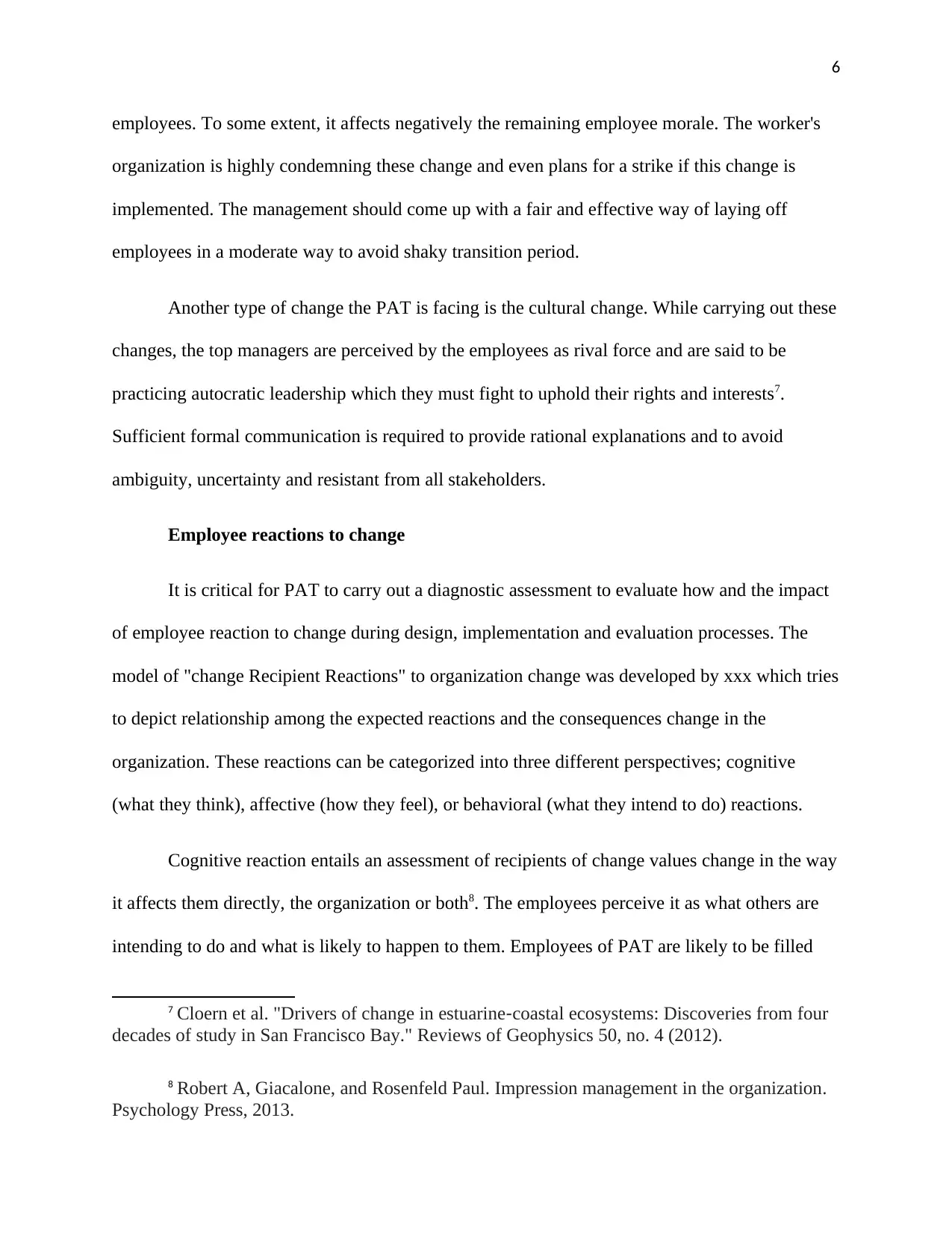
6
employees. To some extent, it affects negatively the remaining employee morale. The worker's
organization is highly condemning these change and even plans for a strike if this change is
implemented. The management should come up with a fair and effective way of laying off
employees in a moderate way to avoid shaky transition period.
Another type of change the PAT is facing is the cultural change. While carrying out these
changes, the top managers are perceived by the employees as rival force and are said to be
practicing autocratic leadership which they must fight to uphold their rights and interests7.
Sufficient formal communication is required to provide rational explanations and to avoid
ambiguity, uncertainty and resistant from all stakeholders.
Employee reactions to change
It is critical for PAT to carry out a diagnostic assessment to evaluate how and the impact
of employee reaction to change during design, implementation and evaluation processes. The
model of "change Recipient Reactions" to organization change was developed by xxx which tries
to depict relationship among the expected reactions and the consequences change in the
organization. These reactions can be categorized into three different perspectives; cognitive
(what they think), affective (how they feel), or behavioral (what they intend to do) reactions.
Cognitive reaction entails an assessment of recipients of change values change in the way
it affects them directly, the organization or both8. The employees perceive it as what others are
intending to do and what is likely to happen to them. Employees of PAT are likely to be filled
7 Cloern et al. "Drivers of change in estuarine‐coastal ecosystems: Discoveries from four
decades of study in San Francisco Bay." Reviews of Geophysics 50, no. 4 (2012).
8 Robert A, Giacalone, and Rosenfeld Paul. Impression management in the organization.
Psychology Press, 2013.
employees. To some extent, it affects negatively the remaining employee morale. The worker's
organization is highly condemning these change and even plans for a strike if this change is
implemented. The management should come up with a fair and effective way of laying off
employees in a moderate way to avoid shaky transition period.
Another type of change the PAT is facing is the cultural change. While carrying out these
changes, the top managers are perceived by the employees as rival force and are said to be
practicing autocratic leadership which they must fight to uphold their rights and interests7.
Sufficient formal communication is required to provide rational explanations and to avoid
ambiguity, uncertainty and resistant from all stakeholders.
Employee reactions to change
It is critical for PAT to carry out a diagnostic assessment to evaluate how and the impact
of employee reaction to change during design, implementation and evaluation processes. The
model of "change Recipient Reactions" to organization change was developed by xxx which tries
to depict relationship among the expected reactions and the consequences change in the
organization. These reactions can be categorized into three different perspectives; cognitive
(what they think), affective (how they feel), or behavioral (what they intend to do) reactions.
Cognitive reaction entails an assessment of recipients of change values change in the way
it affects them directly, the organization or both8. The employees perceive it as what others are
intending to do and what is likely to happen to them. Employees of PAT are likely to be filled
7 Cloern et al. "Drivers of change in estuarine‐coastal ecosystems: Discoveries from four
decades of study in San Francisco Bay." Reviews of Geophysics 50, no. 4 (2012).
8 Robert A, Giacalone, and Rosenfeld Paul. Impression management in the organization.
Psychology Press, 2013.
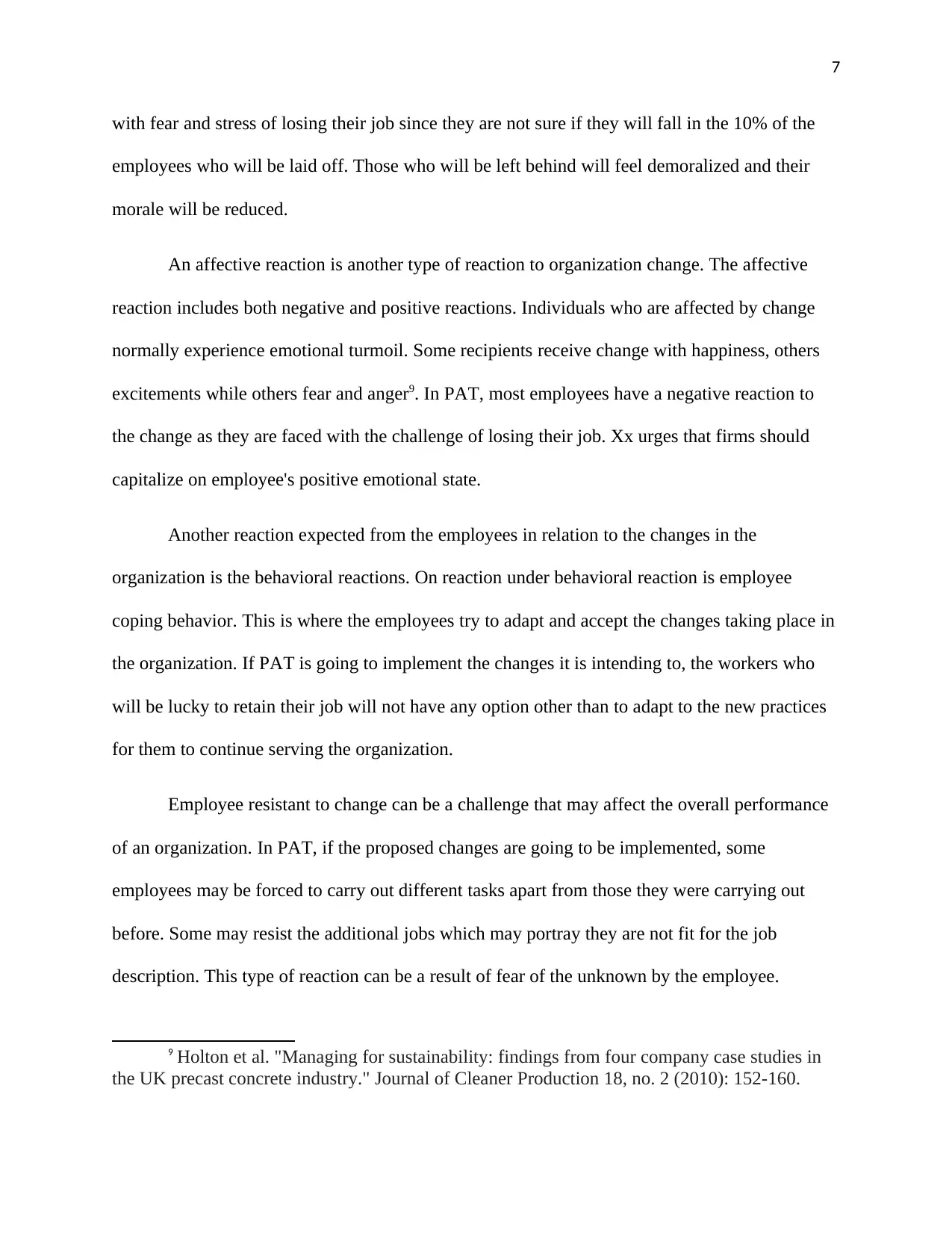
7
with fear and stress of losing their job since they are not sure if they will fall in the 10% of the
employees who will be laid off. Those who will be left behind will feel demoralized and their
morale will be reduced.
An affective reaction is another type of reaction to organization change. The affective
reaction includes both negative and positive reactions. Individuals who are affected by change
normally experience emotional turmoil. Some recipients receive change with happiness, others
excitements while others fear and anger9. In PAT, most employees have a negative reaction to
the change as they are faced with the challenge of losing their job. Xx urges that firms should
capitalize on employee's positive emotional state.
Another reaction expected from the employees in relation to the changes in the
organization is the behavioral reactions. On reaction under behavioral reaction is employee
coping behavior. This is where the employees try to adapt and accept the changes taking place in
the organization. If PAT is going to implement the changes it is intending to, the workers who
will be lucky to retain their job will not have any option other than to adapt to the new practices
for them to continue serving the organization.
Employee resistant to change can be a challenge that may affect the overall performance
of an organization. In PAT, if the proposed changes are going to be implemented, some
employees may be forced to carry out different tasks apart from those they were carrying out
before. Some may resist the additional jobs which may portray they are not fit for the job
description. This type of reaction can be a result of fear of the unknown by the employee.
9 Holton et al. "Managing for sustainability: findings from four company case studies in
the UK precast concrete industry." Journal of Cleaner Production 18, no. 2 (2010): 152-160.
with fear and stress of losing their job since they are not sure if they will fall in the 10% of the
employees who will be laid off. Those who will be left behind will feel demoralized and their
morale will be reduced.
An affective reaction is another type of reaction to organization change. The affective
reaction includes both negative and positive reactions. Individuals who are affected by change
normally experience emotional turmoil. Some recipients receive change with happiness, others
excitements while others fear and anger9. In PAT, most employees have a negative reaction to
the change as they are faced with the challenge of losing their job. Xx urges that firms should
capitalize on employee's positive emotional state.
Another reaction expected from the employees in relation to the changes in the
organization is the behavioral reactions. On reaction under behavioral reaction is employee
coping behavior. This is where the employees try to adapt and accept the changes taking place in
the organization. If PAT is going to implement the changes it is intending to, the workers who
will be lucky to retain their job will not have any option other than to adapt to the new practices
for them to continue serving the organization.
Employee resistant to change can be a challenge that may affect the overall performance
of an organization. In PAT, if the proposed changes are going to be implemented, some
employees may be forced to carry out different tasks apart from those they were carrying out
before. Some may resist the additional jobs which may portray they are not fit for the job
description. This type of reaction can be a result of fear of the unknown by the employee.
9 Holton et al. "Managing for sustainability: findings from four company case studies in
the UK precast concrete industry." Journal of Cleaner Production 18, no. 2 (2010): 152-160.
Paraphrase This Document
Need a fresh take? Get an instant paraphrase of this document with our AI Paraphraser
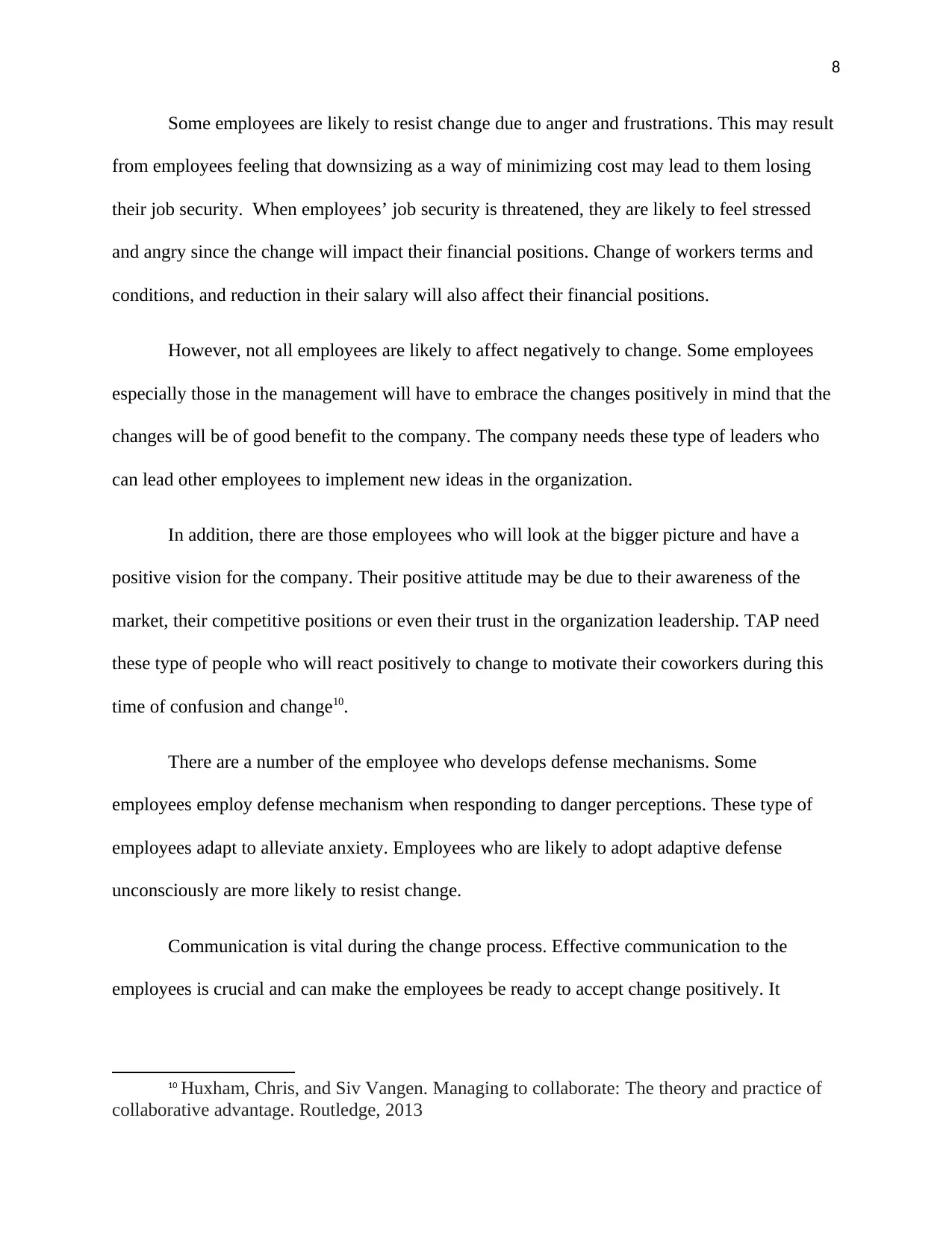
8
Some employees are likely to resist change due to anger and frustrations. This may result
from employees feeling that downsizing as a way of minimizing cost may lead to them losing
their job security. When employees’ job security is threatened, they are likely to feel stressed
and angry since the change will impact their financial positions. Change of workers terms and
conditions, and reduction in their salary will also affect their financial positions.
However, not all employees are likely to affect negatively to change. Some employees
especially those in the management will have to embrace the changes positively in mind that the
changes will be of good benefit to the company. The company needs these type of leaders who
can lead other employees to implement new ideas in the organization.
In addition, there are those employees who will look at the bigger picture and have a
positive vision for the company. Their positive attitude may be due to their awareness of the
market, their competitive positions or even their trust in the organization leadership. TAP need
these type of people who will react positively to change to motivate their coworkers during this
time of confusion and change10.
There are a number of the employee who develops defense mechanisms. Some
employees employ defense mechanism when responding to danger perceptions. These type of
employees adapt to alleviate anxiety. Employees who are likely to adopt adaptive defense
unconsciously are more likely to resist change.
Communication is vital during the change process. Effective communication to the
employees is crucial and can make the employees be ready to accept change positively. It
10 Huxham, Chris, and Siv Vangen. Managing to collaborate: The theory and practice of
collaborative advantage. Routledge, 2013
Some employees are likely to resist change due to anger and frustrations. This may result
from employees feeling that downsizing as a way of minimizing cost may lead to them losing
their job security. When employees’ job security is threatened, they are likely to feel stressed
and angry since the change will impact their financial positions. Change of workers terms and
conditions, and reduction in their salary will also affect their financial positions.
However, not all employees are likely to affect negatively to change. Some employees
especially those in the management will have to embrace the changes positively in mind that the
changes will be of good benefit to the company. The company needs these type of leaders who
can lead other employees to implement new ideas in the organization.
In addition, there are those employees who will look at the bigger picture and have a
positive vision for the company. Their positive attitude may be due to their awareness of the
market, their competitive positions or even their trust in the organization leadership. TAP need
these type of people who will react positively to change to motivate their coworkers during this
time of confusion and change10.
There are a number of the employee who develops defense mechanisms. Some
employees employ defense mechanism when responding to danger perceptions. These type of
employees adapt to alleviate anxiety. Employees who are likely to adopt adaptive defense
unconsciously are more likely to resist change.
Communication is vital during the change process. Effective communication to the
employees is crucial and can make the employees be ready to accept change positively. It
10 Huxham, Chris, and Siv Vangen. Managing to collaborate: The theory and practice of
collaborative advantage. Routledge, 2013
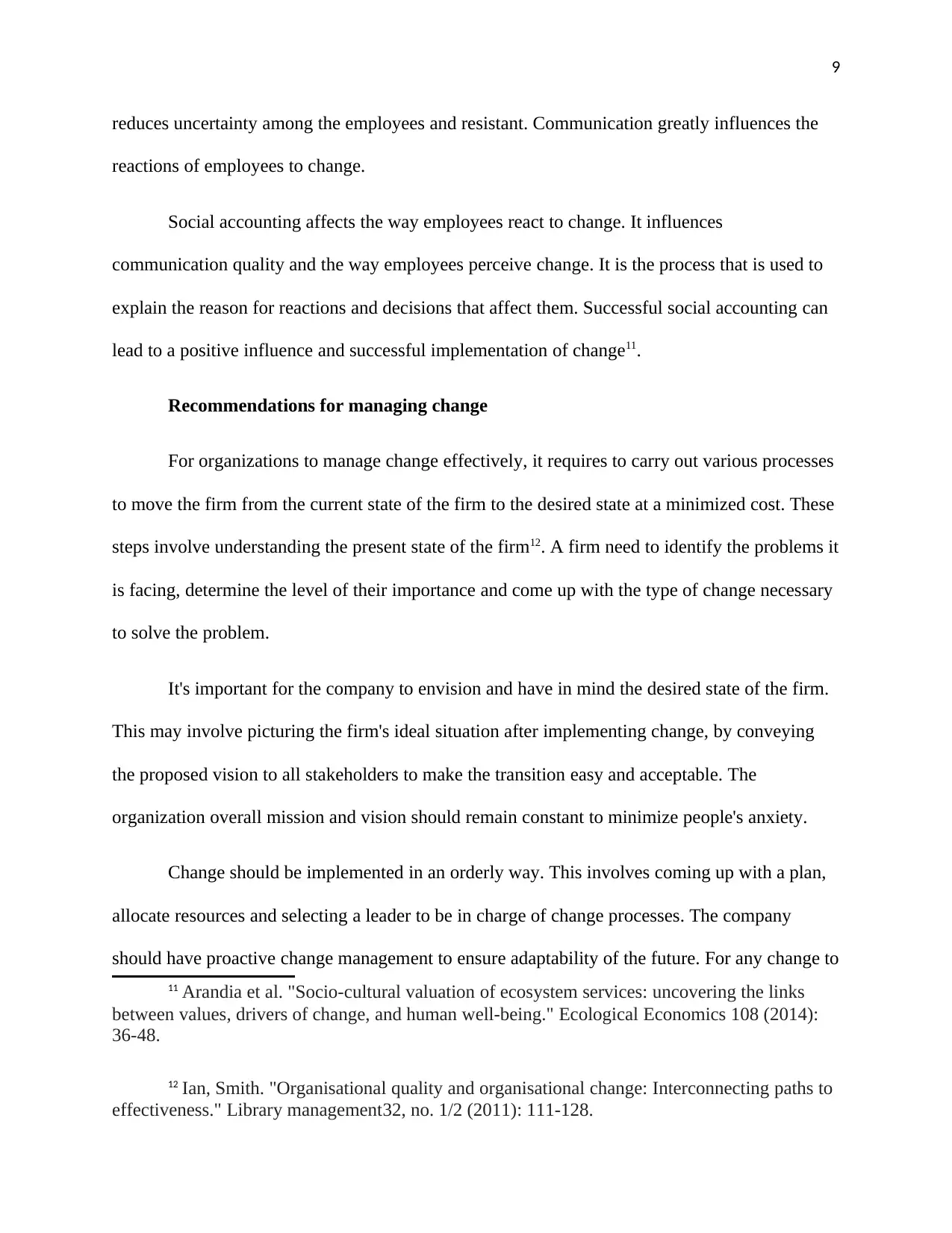
9
reduces uncertainty among the employees and resistant. Communication greatly influences the
reactions of employees to change.
Social accounting affects the way employees react to change. It influences
communication quality and the way employees perceive change. It is the process that is used to
explain the reason for reactions and decisions that affect them. Successful social accounting can
lead to a positive influence and successful implementation of change11.
Recommendations for managing change
For organizations to manage change effectively, it requires to carry out various processes
to move the firm from the current state of the firm to the desired state at a minimized cost. These
steps involve understanding the present state of the firm12. A firm need to identify the problems it
is facing, determine the level of their importance and come up with the type of change necessary
to solve the problem.
It's important for the company to envision and have in mind the desired state of the firm.
This may involve picturing the firm's ideal situation after implementing change, by conveying
the proposed vision to all stakeholders to make the transition easy and acceptable. The
organization overall mission and vision should remain constant to minimize people's anxiety.
Change should be implemented in an orderly way. This involves coming up with a plan,
allocate resources and selecting a leader to be in charge of change processes. The company
should have proactive change management to ensure adaptability of the future. For any change to
11 Arandia et al. "Socio-cultural valuation of ecosystem services: uncovering the links
between values, drivers of change, and human well-being." Ecological Economics 108 (2014):
36-48.
12 Ian, Smith. "Organisational quality and organisational change: Interconnecting paths to
effectiveness." Library management32, no. 1/2 (2011): 111-128.
reduces uncertainty among the employees and resistant. Communication greatly influences the
reactions of employees to change.
Social accounting affects the way employees react to change. It influences
communication quality and the way employees perceive change. It is the process that is used to
explain the reason for reactions and decisions that affect them. Successful social accounting can
lead to a positive influence and successful implementation of change11.
Recommendations for managing change
For organizations to manage change effectively, it requires to carry out various processes
to move the firm from the current state of the firm to the desired state at a minimized cost. These
steps involve understanding the present state of the firm12. A firm need to identify the problems it
is facing, determine the level of their importance and come up with the type of change necessary
to solve the problem.
It's important for the company to envision and have in mind the desired state of the firm.
This may involve picturing the firm's ideal situation after implementing change, by conveying
the proposed vision to all stakeholders to make the transition easy and acceptable. The
organization overall mission and vision should remain constant to minimize people's anxiety.
Change should be implemented in an orderly way. This involves coming up with a plan,
allocate resources and selecting a leader to be in charge of change processes. The company
should have proactive change management to ensure adaptability of the future. For any change to
11 Arandia et al. "Socio-cultural valuation of ecosystem services: uncovering the links
between values, drivers of change, and human well-being." Ecological Economics 108 (2014):
36-48.
12 Ian, Smith. "Organisational quality and organisational change: Interconnecting paths to
effectiveness." Library management32, no. 1/2 (2011): 111-128.
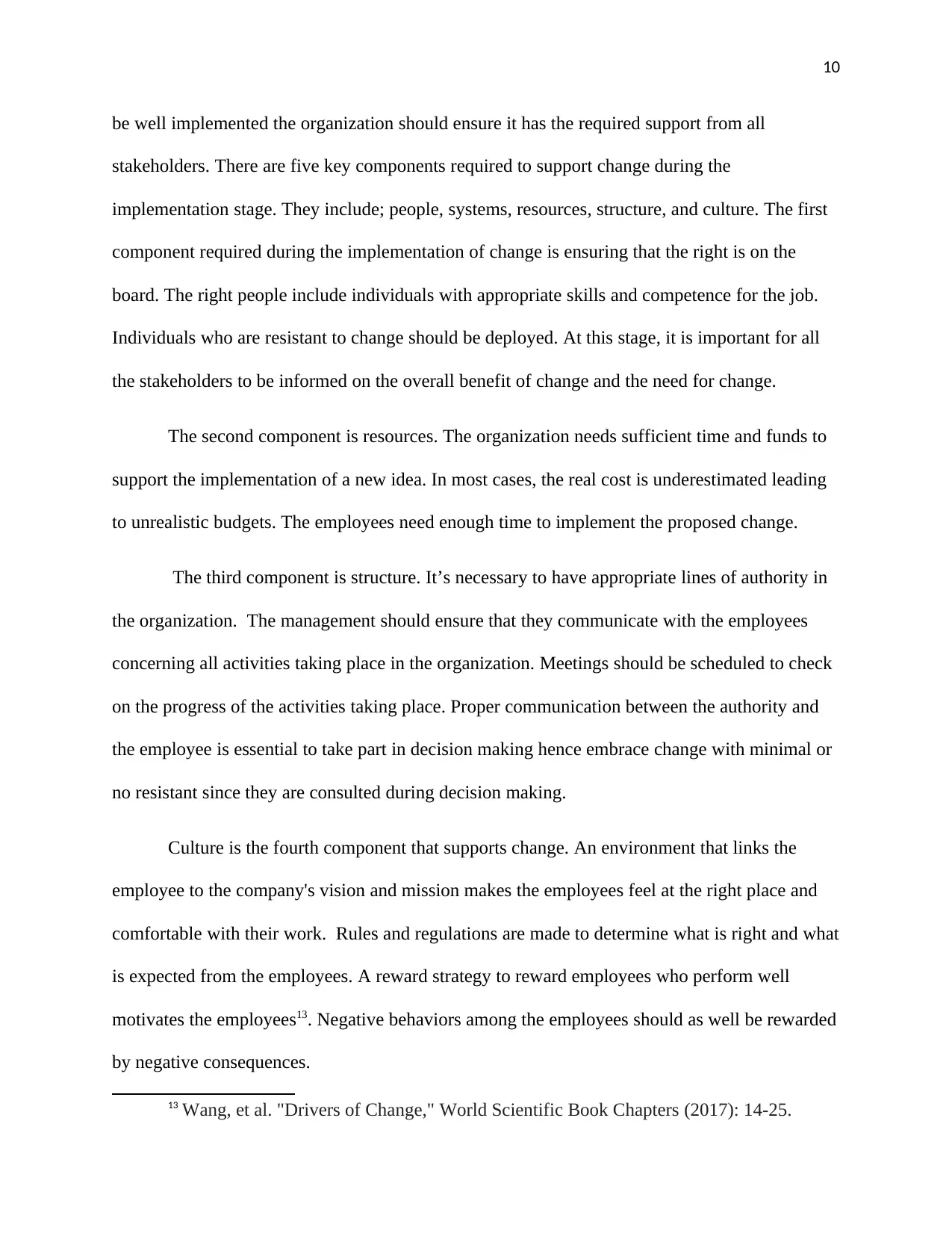
10
be well implemented the organization should ensure it has the required support from all
stakeholders. There are five key components required to support change during the
implementation stage. They include; people, systems, resources, structure, and culture. The first
component required during the implementation of change is ensuring that the right is on the
board. The right people include individuals with appropriate skills and competence for the job.
Individuals who are resistant to change should be deployed. At this stage, it is important for all
the stakeholders to be informed on the overall benefit of change and the need for change.
The second component is resources. The organization needs sufficient time and funds to
support the implementation of a new idea. In most cases, the real cost is underestimated leading
to unrealistic budgets. The employees need enough time to implement the proposed change.
The third component is structure. It’s necessary to have appropriate lines of authority in
the organization. The management should ensure that they communicate with the employees
concerning all activities taking place in the organization. Meetings should be scheduled to check
on the progress of the activities taking place. Proper communication between the authority and
the employee is essential to take part in decision making hence embrace change with minimal or
no resistant since they are consulted during decision making.
Culture is the fourth component that supports change. An environment that links the
employee to the company's vision and mission makes the employees feel at the right place and
comfortable with their work. Rules and regulations are made to determine what is right and what
is expected from the employees. A reward strategy to reward employees who perform well
motivates the employees13. Negative behaviors among the employees should as well be rewarded
by negative consequences.
13 Wang, et al. "Drivers of Change," World Scientific Book Chapters (2017): 14-25.
be well implemented the organization should ensure it has the required support from all
stakeholders. There are five key components required to support change during the
implementation stage. They include; people, systems, resources, structure, and culture. The first
component required during the implementation of change is ensuring that the right is on the
board. The right people include individuals with appropriate skills and competence for the job.
Individuals who are resistant to change should be deployed. At this stage, it is important for all
the stakeholders to be informed on the overall benefit of change and the need for change.
The second component is resources. The organization needs sufficient time and funds to
support the implementation of a new idea. In most cases, the real cost is underestimated leading
to unrealistic budgets. The employees need enough time to implement the proposed change.
The third component is structure. It’s necessary to have appropriate lines of authority in
the organization. The management should ensure that they communicate with the employees
concerning all activities taking place in the organization. Meetings should be scheduled to check
on the progress of the activities taking place. Proper communication between the authority and
the employee is essential to take part in decision making hence embrace change with minimal or
no resistant since they are consulted during decision making.
Culture is the fourth component that supports change. An environment that links the
employee to the company's vision and mission makes the employees feel at the right place and
comfortable with their work. Rules and regulations are made to determine what is right and what
is expected from the employees. A reward strategy to reward employees who perform well
motivates the employees13. Negative behaviors among the employees should as well be rewarded
by negative consequences.
13 Wang, et al. "Drivers of Change," World Scientific Book Chapters (2017): 14-25.
Secure Best Marks with AI Grader
Need help grading? Try our AI Grader for instant feedback on your assignments.
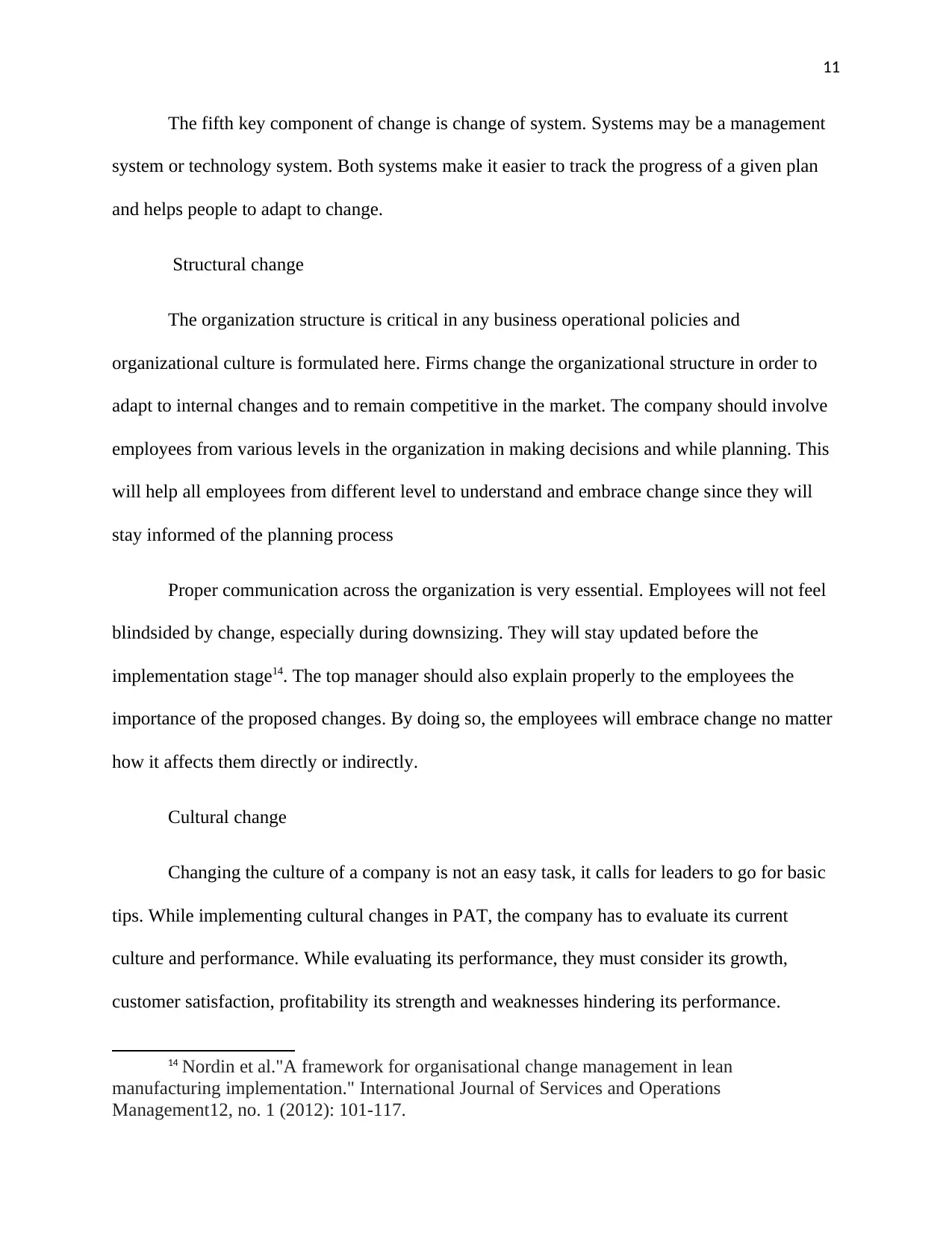
11
The fifth key component of change is change of system. Systems may be a management
system or technology system. Both systems make it easier to track the progress of a given plan
and helps people to adapt to change.
Structural change
The organization structure is critical in any business operational policies and
organizational culture is formulated here. Firms change the organizational structure in order to
adapt to internal changes and to remain competitive in the market. The company should involve
employees from various levels in the organization in making decisions and while planning. This
will help all employees from different level to understand and embrace change since they will
stay informed of the planning process
Proper communication across the organization is very essential. Employees will not feel
blindsided by change, especially during downsizing. They will stay updated before the
implementation stage14. The top manager should also explain properly to the employees the
importance of the proposed changes. By doing so, the employees will embrace change no matter
how it affects them directly or indirectly.
Cultural change
Changing the culture of a company is not an easy task, it calls for leaders to go for basic
tips. While implementing cultural changes in PAT, the company has to evaluate its current
culture and performance. While evaluating its performance, they must consider its growth,
customer satisfaction, profitability its strength and weaknesses hindering its performance.
14 Nordin et al."A framework for organisational change management in lean
manufacturing implementation." International Journal of Services and Operations
Management12, no. 1 (2012): 101-117.
The fifth key component of change is change of system. Systems may be a management
system or technology system. Both systems make it easier to track the progress of a given plan
and helps people to adapt to change.
Structural change
The organization structure is critical in any business operational policies and
organizational culture is formulated here. Firms change the organizational structure in order to
adapt to internal changes and to remain competitive in the market. The company should involve
employees from various levels in the organization in making decisions and while planning. This
will help all employees from different level to understand and embrace change since they will
stay informed of the planning process
Proper communication across the organization is very essential. Employees will not feel
blindsided by change, especially during downsizing. They will stay updated before the
implementation stage14. The top manager should also explain properly to the employees the
importance of the proposed changes. By doing so, the employees will embrace change no matter
how it affects them directly or indirectly.
Cultural change
Changing the culture of a company is not an easy task, it calls for leaders to go for basic
tips. While implementing cultural changes in PAT, the company has to evaluate its current
culture and performance. While evaluating its performance, they must consider its growth,
customer satisfaction, profitability its strength and weaknesses hindering its performance.
14 Nordin et al."A framework for organisational change management in lean
manufacturing implementation." International Journal of Services and Operations
Management12, no. 1 (2012): 101-117.
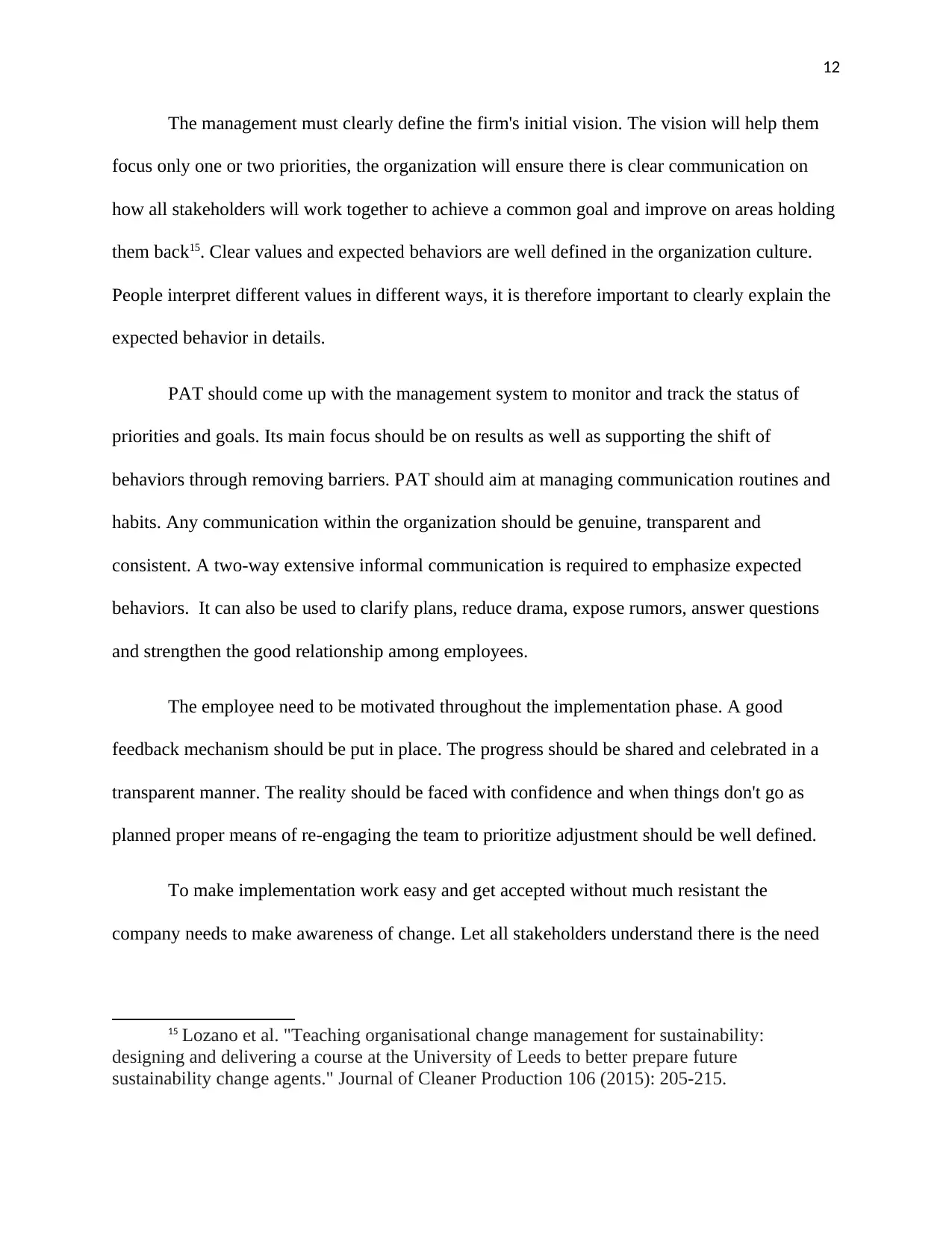
12
The management must clearly define the firm's initial vision. The vision will help them
focus only one or two priorities, the organization will ensure there is clear communication on
how all stakeholders will work together to achieve a common goal and improve on areas holding
them back15. Clear values and expected behaviors are well defined in the organization culture.
People interpret different values in different ways, it is therefore important to clearly explain the
expected behavior in details.
PAT should come up with the management system to monitor and track the status of
priorities and goals. Its main focus should be on results as well as supporting the shift of
behaviors through removing barriers. PAT should aim at managing communication routines and
habits. Any communication within the organization should be genuine, transparent and
consistent. A two-way extensive informal communication is required to emphasize expected
behaviors. It can also be used to clarify plans, reduce drama, expose rumors, answer questions
and strengthen the good relationship among employees.
The employee need to be motivated throughout the implementation phase. A good
feedback mechanism should be put in place. The progress should be shared and celebrated in a
transparent manner. The reality should be faced with confidence and when things don't go as
planned proper means of re-engaging the team to prioritize adjustment should be well defined.
To make implementation work easy and get accepted without much resistant the
company needs to make awareness of change. Let all stakeholders understand there is the need
15 Lozano et al. "Teaching organisational change management for sustainability:
designing and delivering a course at the University of Leeds to better prepare future
sustainability change agents." Journal of Cleaner Production 106 (2015): 205-215.
The management must clearly define the firm's initial vision. The vision will help them
focus only one or two priorities, the organization will ensure there is clear communication on
how all stakeholders will work together to achieve a common goal and improve on areas holding
them back15. Clear values and expected behaviors are well defined in the organization culture.
People interpret different values in different ways, it is therefore important to clearly explain the
expected behavior in details.
PAT should come up with the management system to monitor and track the status of
priorities and goals. Its main focus should be on results as well as supporting the shift of
behaviors through removing barriers. PAT should aim at managing communication routines and
habits. Any communication within the organization should be genuine, transparent and
consistent. A two-way extensive informal communication is required to emphasize expected
behaviors. It can also be used to clarify plans, reduce drama, expose rumors, answer questions
and strengthen the good relationship among employees.
The employee need to be motivated throughout the implementation phase. A good
feedback mechanism should be put in place. The progress should be shared and celebrated in a
transparent manner. The reality should be faced with confidence and when things don't go as
planned proper means of re-engaging the team to prioritize adjustment should be well defined.
To make implementation work easy and get accepted without much resistant the
company needs to make awareness of change. Let all stakeholders understand there is the need
15 Lozano et al. "Teaching organisational change management for sustainability:
designing and delivering a course at the University of Leeds to better prepare future
sustainability change agents." Journal of Cleaner Production 106 (2015): 205-215.
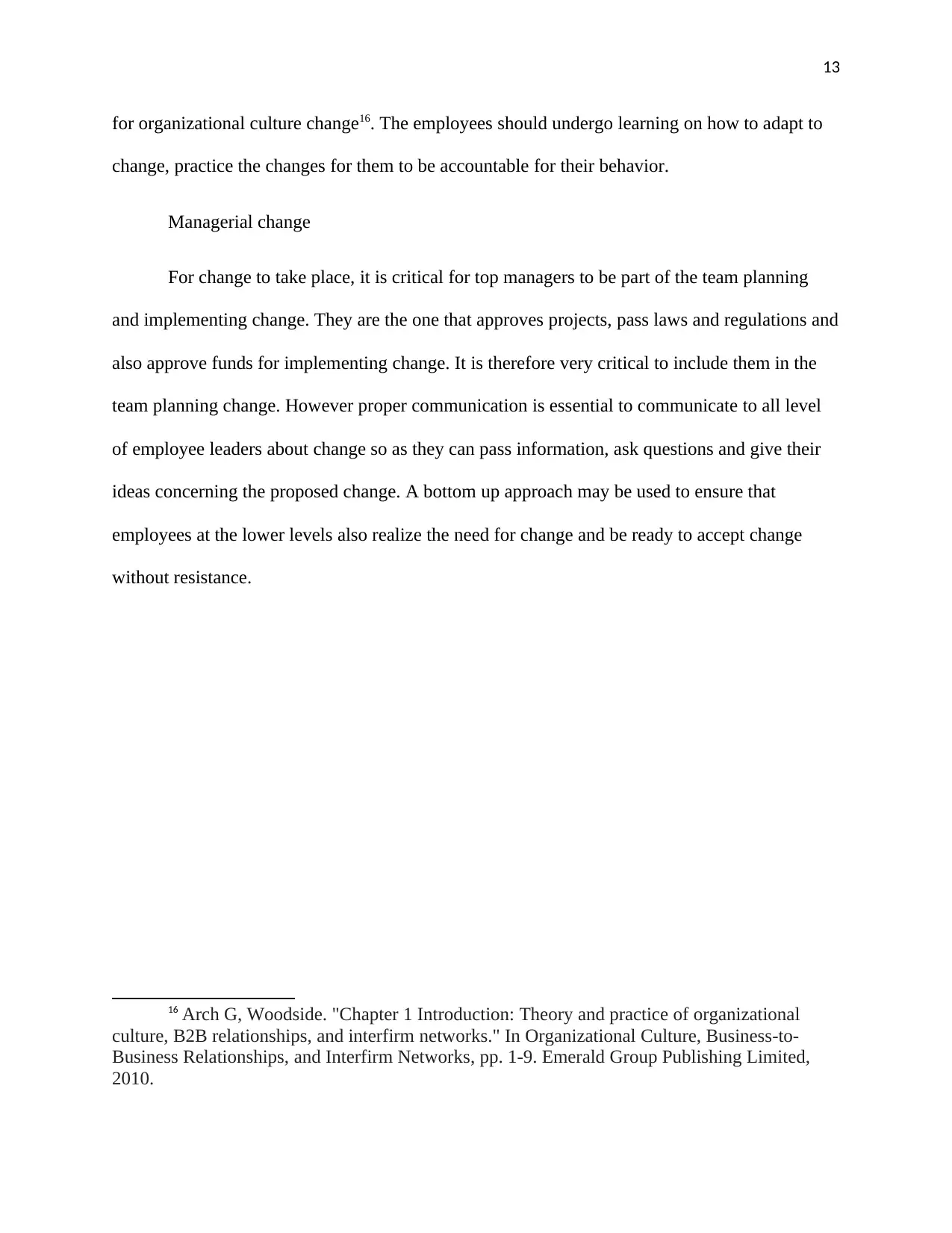
13
for organizational culture change16. The employees should undergo learning on how to adapt to
change, practice the changes for them to be accountable for their behavior.
Managerial change
For change to take place, it is critical for top managers to be part of the team planning
and implementing change. They are the one that approves projects, pass laws and regulations and
also approve funds for implementing change. It is therefore very critical to include them in the
team planning change. However proper communication is essential to communicate to all level
of employee leaders about change so as they can pass information, ask questions and give their
ideas concerning the proposed change. A bottom up approach may be used to ensure that
employees at the lower levels also realize the need for change and be ready to accept change
without resistance.
16 Arch G, Woodside. "Chapter 1 Introduction: Theory and practice of organizational
culture, B2B relationships, and interfirm networks." In Organizational Culture, Business-to-
Business Relationships, and Interfirm Networks, pp. 1-9. Emerald Group Publishing Limited,
2010.
for organizational culture change16. The employees should undergo learning on how to adapt to
change, practice the changes for them to be accountable for their behavior.
Managerial change
For change to take place, it is critical for top managers to be part of the team planning
and implementing change. They are the one that approves projects, pass laws and regulations and
also approve funds for implementing change. It is therefore very critical to include them in the
team planning change. However proper communication is essential to communicate to all level
of employee leaders about change so as they can pass information, ask questions and give their
ideas concerning the proposed change. A bottom up approach may be used to ensure that
employees at the lower levels also realize the need for change and be ready to accept change
without resistance.
16 Arch G, Woodside. "Chapter 1 Introduction: Theory and practice of organizational
culture, B2B relationships, and interfirm networks." In Organizational Culture, Business-to-
Business Relationships, and Interfirm Networks, pp. 1-9. Emerald Group Publishing Limited,
2010.
Paraphrase This Document
Need a fresh take? Get an instant paraphrase of this document with our AI Paraphraser
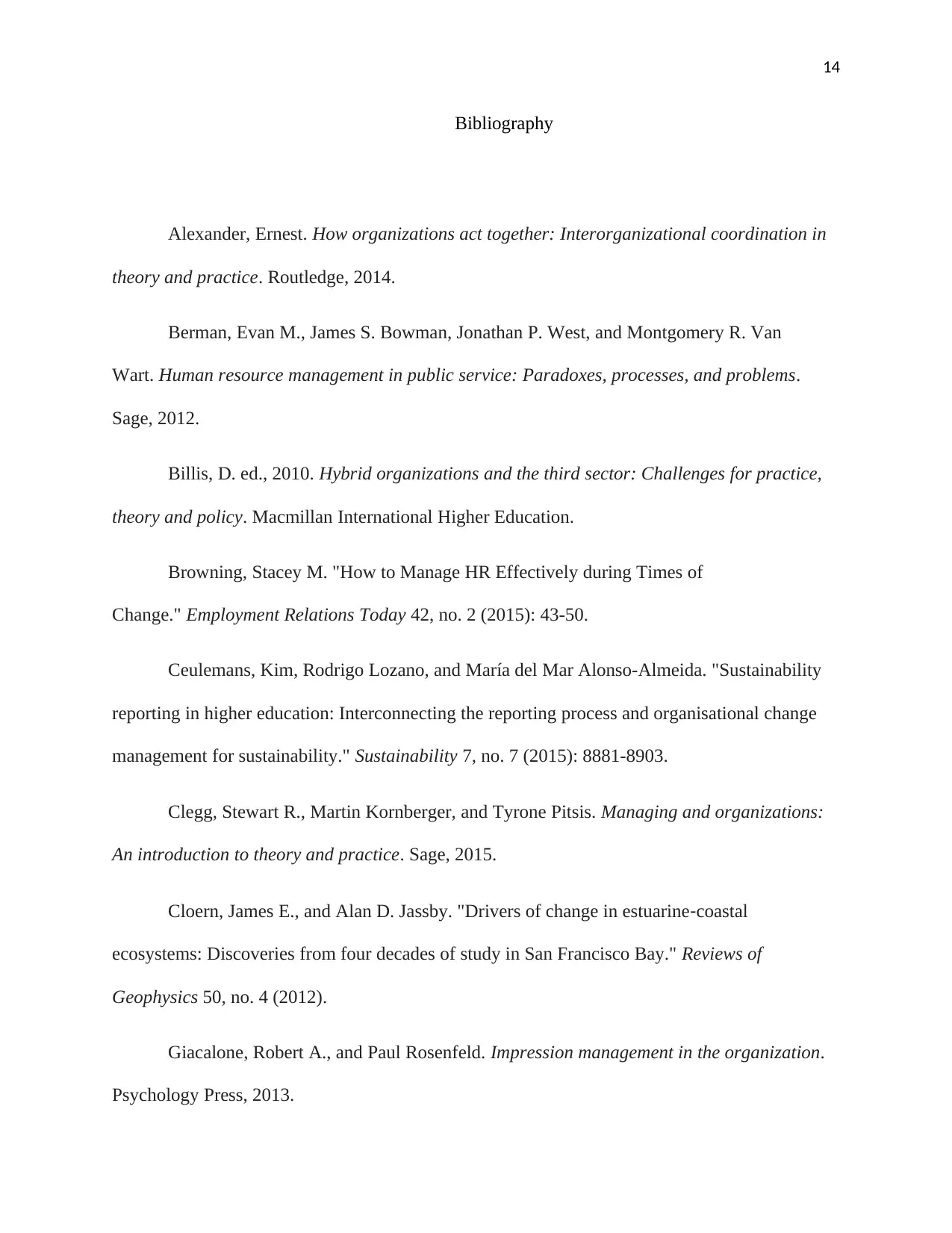
14
Bibliography
Alexander, Ernest. How organizations act together: Interorganizational coordination in
theory and practice. Routledge, 2014.
Berman, Evan M., James S. Bowman, Jonathan P. West, and Montgomery R. Van
Wart. Human resource management in public service: Paradoxes, processes, and problems.
Sage, 2012.
Billis, D. ed., 2010. Hybrid organizations and the third sector: Challenges for practice,
theory and policy. Macmillan International Higher Education.
Browning, Stacey M. "How to Manage HR Effectively during Times of
Change." Employment Relations Today 42, no. 2 (2015): 43-50.
Ceulemans, Kim, Rodrigo Lozano, and María del Mar Alonso-Almeida. "Sustainability
reporting in higher education: Interconnecting the reporting process and organisational change
management for sustainability." Sustainability 7, no. 7 (2015): 8881-8903.
Clegg, Stewart R., Martin Kornberger, and Tyrone Pitsis. Managing and organizations:
An introduction to theory and practice. Sage, 2015.
Cloern, James E., and Alan D. Jassby. "Drivers of change in estuarine‐coastal
ecosystems: Discoveries from four decades of study in San Francisco Bay." Reviews of
Geophysics 50, no. 4 (2012).
Giacalone, Robert A., and Paul Rosenfeld. Impression management in the organization.
Psychology Press, 2013.
Bibliography
Alexander, Ernest. How organizations act together: Interorganizational coordination in
theory and practice. Routledge, 2014.
Berman, Evan M., James S. Bowman, Jonathan P. West, and Montgomery R. Van
Wart. Human resource management in public service: Paradoxes, processes, and problems.
Sage, 2012.
Billis, D. ed., 2010. Hybrid organizations and the third sector: Challenges for practice,
theory and policy. Macmillan International Higher Education.
Browning, Stacey M. "How to Manage HR Effectively during Times of
Change." Employment Relations Today 42, no. 2 (2015): 43-50.
Ceulemans, Kim, Rodrigo Lozano, and María del Mar Alonso-Almeida. "Sustainability
reporting in higher education: Interconnecting the reporting process and organisational change
management for sustainability." Sustainability 7, no. 7 (2015): 8881-8903.
Clegg, Stewart R., Martin Kornberger, and Tyrone Pitsis. Managing and organizations:
An introduction to theory and practice. Sage, 2015.
Cloern, James E., and Alan D. Jassby. "Drivers of change in estuarine‐coastal
ecosystems: Discoveries from four decades of study in San Francisco Bay." Reviews of
Geophysics 50, no. 4 (2012).
Giacalone, Robert A., and Paul Rosenfeld. Impression management in the organization.
Psychology Press, 2013.
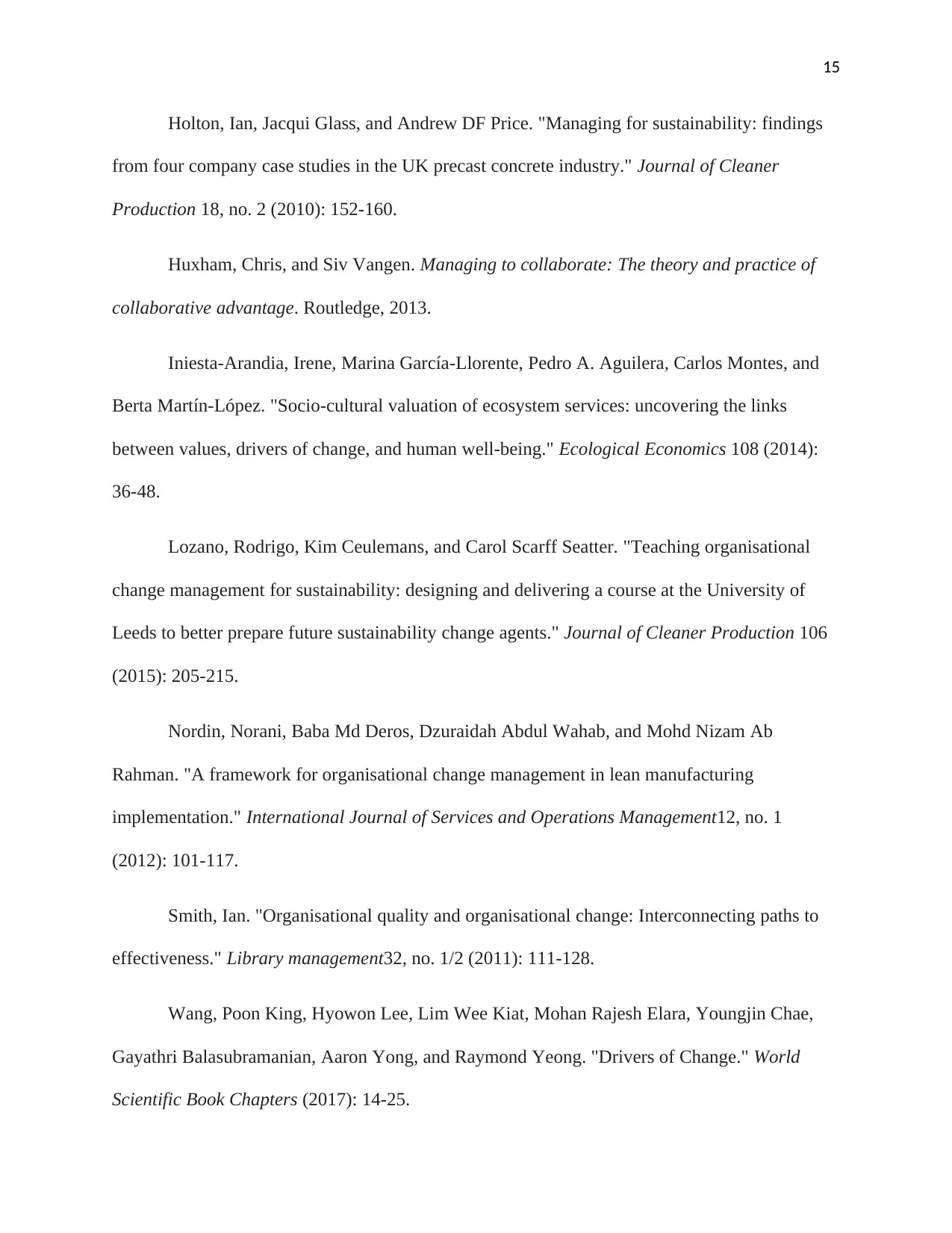
15
Holton, Ian, Jacqui Glass, and Andrew DF Price. "Managing for sustainability: findings
from four company case studies in the UK precast concrete industry." Journal of Cleaner
Production 18, no. 2 (2010): 152-160.
Huxham, Chris, and Siv Vangen. Managing to collaborate: The theory and practice of
collaborative advantage. Routledge, 2013.
Iniesta-Arandia, Irene, Marina García-Llorente, Pedro A. Aguilera, Carlos Montes, and
Berta Martín-López. "Socio-cultural valuation of ecosystem services: uncovering the links
between values, drivers of change, and human well-being." Ecological Economics 108 (2014):
36-48.
Lozano, Rodrigo, Kim Ceulemans, and Carol Scarff Seatter. "Teaching organisational
change management for sustainability: designing and delivering a course at the University of
Leeds to better prepare future sustainability change agents." Journal of Cleaner Production 106
(2015): 205-215.
Nordin, Norani, Baba Md Deros, Dzuraidah Abdul Wahab, and Mohd Nizam Ab
Rahman. "A framework for organisational change management in lean manufacturing
implementation." International Journal of Services and Operations Management12, no. 1
(2012): 101-117.
Smith, Ian. "Organisational quality and organisational change: Interconnecting paths to
effectiveness." Library management32, no. 1/2 (2011): 111-128.
Wang, Poon King, Hyowon Lee, Lim Wee Kiat, Mohan Rajesh Elara, Youngjin Chae,
Gayathri Balasubramanian, Aaron Yong, and Raymond Yeong. "Drivers of Change." World
Scientific Book Chapters (2017): 14-25.
Holton, Ian, Jacqui Glass, and Andrew DF Price. "Managing for sustainability: findings
from four company case studies in the UK precast concrete industry." Journal of Cleaner
Production 18, no. 2 (2010): 152-160.
Huxham, Chris, and Siv Vangen. Managing to collaborate: The theory and practice of
collaborative advantage. Routledge, 2013.
Iniesta-Arandia, Irene, Marina García-Llorente, Pedro A. Aguilera, Carlos Montes, and
Berta Martín-López. "Socio-cultural valuation of ecosystem services: uncovering the links
between values, drivers of change, and human well-being." Ecological Economics 108 (2014):
36-48.
Lozano, Rodrigo, Kim Ceulemans, and Carol Scarff Seatter. "Teaching organisational
change management for sustainability: designing and delivering a course at the University of
Leeds to better prepare future sustainability change agents." Journal of Cleaner Production 106
(2015): 205-215.
Nordin, Norani, Baba Md Deros, Dzuraidah Abdul Wahab, and Mohd Nizam Ab
Rahman. "A framework for organisational change management in lean manufacturing
implementation." International Journal of Services and Operations Management12, no. 1
(2012): 101-117.
Smith, Ian. "Organisational quality and organisational change: Interconnecting paths to
effectiveness." Library management32, no. 1/2 (2011): 111-128.
Wang, Poon King, Hyowon Lee, Lim Wee Kiat, Mohan Rajesh Elara, Youngjin Chae,
Gayathri Balasubramanian, Aaron Yong, and Raymond Yeong. "Drivers of Change." World
Scientific Book Chapters (2017): 14-25.
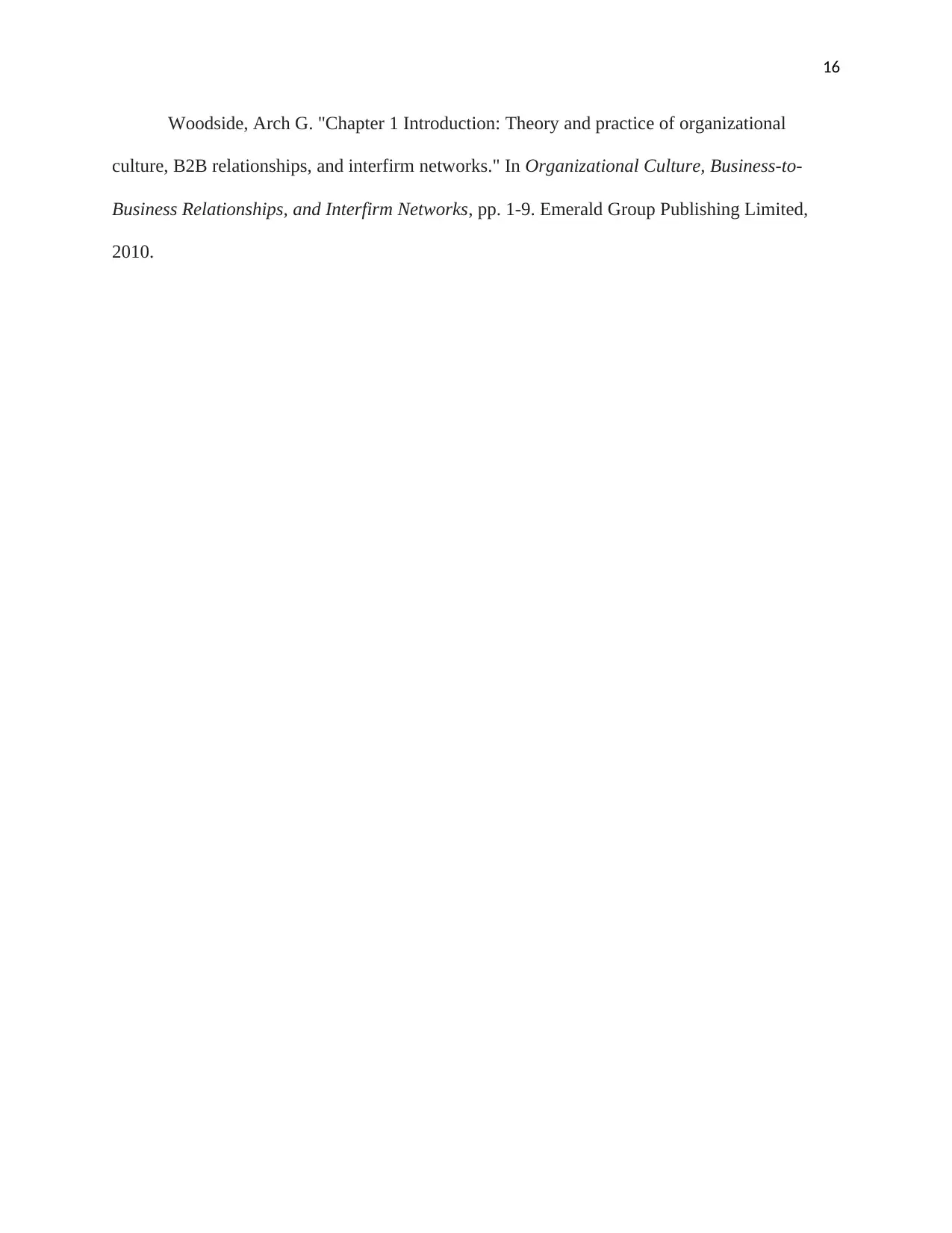
16
Woodside, Arch G. "Chapter 1 Introduction: Theory and practice of organizational
culture, B2B relationships, and interfirm networks." In Organizational Culture, Business-to-
Business Relationships, and Interfirm Networks, pp. 1-9. Emerald Group Publishing Limited,
2010.
Woodside, Arch G. "Chapter 1 Introduction: Theory and practice of organizational
culture, B2B relationships, and interfirm networks." In Organizational Culture, Business-to-
Business Relationships, and Interfirm Networks, pp. 1-9. Emerald Group Publishing Limited,
2010.
1 out of 16
Related Documents
Your All-in-One AI-Powered Toolkit for Academic Success.
+13062052269
info@desklib.com
Available 24*7 on WhatsApp / Email
![[object Object]](/_next/static/media/star-bottom.7253800d.svg)
Unlock your academic potential
© 2024 | Zucol Services PVT LTD | All rights reserved.




